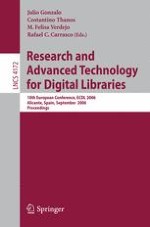2006 | Buch
Research and Advanced Technology for Digital Libraries
10th European Conference, ECDL 2006, Alicante, Spain, September 17-22, 2006. Proceedings
herausgegeben von: Julio Gonzalo, Costantino Thanos, M. Felisa Verdejo, Rafael C. Carrasco
Verlag: Springer Berlin Heidelberg
Buchreihe : Lecture Notes in Computer Science
